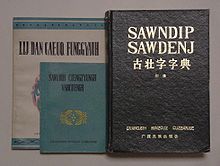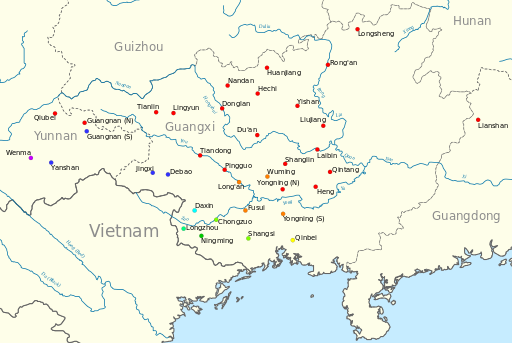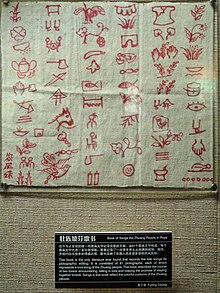Zhuang languages
| Zhuang | |
|---|---|
| Vahcuengh (za), Hauqcuengh (zyb) Kauqnuangz, Kauqnoangz (zhn) Hoedyaej (zgn), Hauƽyəiч (zqe) Hauqraeuz, Gangjdoj (zyb, zhn, zqe) Kauqraeuz, Gangjtoj (zhn, zyg, zhd) | |
| Native to | China |
| Ethnicity | Zhuang people |
Native speakers | 16 million, all Northern Zhuang languages (2007)[1] |
Kra–Dai
| |
Standard forms | |
| Zhuang, Old Zhuang, Sawndip, Sawgoek | |
| Language codes | |
| ISO 639-1 | za |
| ISO 639-2 | zha |
| ISO 639-3 | zha – inclusive codeIndividual codes: zch – Central Hongshuihe Zhuangzhd – Dai Zhuang (Wenma)zeh – Eastern Hongshuihe Zhuangzgb – Guibei Zhuangzgn – Guibian Zhuangzln – Lianshan Zhuangzlj – Liujiang Zhuangzlq – Liuqian Zhuangzgm – Minz Zhuangzhn – Nong Zhuang (Yanguang)zqe – Qiubei Zhuangzyg – Yang Zhuang (Dejing)zyb – Yongbei Zhuangzyn – Yongnan Zhuangzyj – Youjiang Zhuangzzj – Zuojiang Zhuang |
| Glottolog | Nonedaic1237 = Daic; Zhuang is not a valid group |
 Geographic distribution of Zhuang dialects in Guangxi and related languages in Northern Vietnam and Guizhou | |

The Zhuang languages (/ˈdʒwæŋ, ˈdʒwɒŋ/;[2] autonym: Vahcuengh, Zhuang pronunciation: [
The Tai languages are believed to have been originally spoken in what is now southern China, with speakers of the Southwestern Tai languages (which include Thai, Lao and Shan) having emigrated in the face of Chinese expansion. Noting that both the Zhuang and Thai peoples have the same exonym for the Vietnamese, kɛɛuA1,[4] from the Chinese commandery of Jiaozhi in northern Vietnam, Jerold A. Edmondson posited that the split between Zhuang and the Southwestern Tai languages happened no earlier than the founding of Jiaozhi in 112 BC. He also argues that the departure of the Thai from southern China must predate the 5th century AD, when the Tai who remained in China began to take family names.[5]
Surveys
[edit]
Zhāng Jūnrú's (
- Wuming – Shuāngqiáo
雙 橋 – Subgroup M - Hengxian – Nàxù
那 旭 – Subgroup N - Yongning (North) – Wǔtáng
五 塘 – Subgroup N - Pingguo – Xīnxū
新 圩 – Subgroup N - Tiandong – Héhéng
合 恒 – Subgroup N - Tianlin – Lìzhōu
利 周 – Subgroup N - Lingyue – Sìchéng 泗城 – Subgroup N
- Guangnan (Shā people
沙 族 ) – Zhěméng Township者 孟 鄉 – Subgroup N - Qiubei – Gēhán Township
戈 寒 鄉 – Subgroup N - Liujiang – Bǎipéng
百 朋 – Subgroup N - Yishan – Luòdōng
洛 東 – Subgroup N - Huanjiang – Chéngguǎn
城 管 – Subgroup N - Rong'an – Ānzì
安治 – Subgroup N - Longsheng – Rìxīn
日新 – Subgroup N - Hechi – Sānqū
三 區 – Subgroup N - Nandan – Méma 麼麻 – Subgroup N
- Donglan – Chéngxiāng
城 廂 – Subgroup N - Du'an – Liùlǐ
六 里 – Subgroup N - Shanglin – Dàfēng
大豐 – Subgroup N - Laibin – Sìjiǎo
寺 腳 – Subgroup N - Guigang – Shānběi
山北 – Subgroup N - Lianshan – Xiǎosānjiāng
小 三江 – Subgroup N - Qinzhou – Nàhé Township
那 河 鄉 – Subgroup I - Yongning (South) – Xiàfāng Township
下 枋鄉 – Subgroup M - Long'an – Xiǎolín Township
小林 鄉 – Subgroup M - Fusui (Central) – Dàtáng Township
大 塘鄉 – Subgroup M - Shangsi – Jiàodīng Township
叫 丁 鄉 – Subgroup C - Chongzuo – Fùlù Township
福 鹿 鄉 – Subgroup C - Ningming – Fēnghuáng Township
鳳 璜鄉 – Subgroup B - Longzhou – Bīnqiáo Township
彬 橋 鄉 – Subgroup F - Daxin – Hòuyì Township
後 益 鄉 – Subgroup H - Debao – Yuándì'èrqū
原 第 二 區 – Subgroup L - Jingxi – Xīnhé Township
新和 鄉 – Subgroup L - Guangnan (Nóng people
儂 族 ) – Xiǎoguǎngnán Township小 廣 南鄉 – Subgroup L - Yanshan (Nóng people
儂 族 ) – Kuāxī Township誇 西鄉 – Subgroup L - Wenma (Tǔ people
土 族 ) – Hēimò Township黑 末 鄉 大 寨, Dàzhài – Subgroup P
Varieties
[edit]The Zhuang language (or language group) has been divided by Chinese linguists into northern and southern "dialects" (fāngyán
Zhang (1999) identified 13 Zhuang varieties. Later research by the Summer Institute of Linguistics has indicated that some of these are themselves multiple languages that are not mutually intelligible without previous exposure on the part of speakers, resulting in 16 separate ISO 639-3 codes.[9][10]
Northern Zhuang
[edit]Northern Zhuang comprises dialects north of the Yong River, with 8,572,200 speakers[7][11] (Northern Zhuang [ccx] prior to 2007):
- Guibei
桂 北 (1,290,000 speakers): Luocheng, Huanjiang, Rongshui, Rong'an, Sanjiang, Yongfu, Longsheng, Hechi, Nandan, Tian'e, Donglan (Guibei Zhuang [zgb]) - Liujiang
柳 江 (1,297,000 speakers): Liujiang, North Laibin, Yishan, Liucheng, Xincheng (Liujiang Zhuang [zlj]) - Hongshui He
紅 水 河 (2,823,000 speakers): South Laibin, Du'an, Mashan, Shilong, Guixian, Luzhai, Lipu, Yangshuo. Castro and Hansen (2010) distinguished three mutually unintelligible varieties: Central Hongshuihe (Central Hongshuihe Zhuang [zch]), Eastern Hongshuihe (Eastern Hongshuihe Zhuang [zeh]) and Liuqian (Liuqian Zhuang [zlq]).[12] - Yongbei 邕北 (1,448,000 speakers): North Yongning, Wuming (prestige dialect), Binyang, Hengxian, Pingguo (Yongbei Zhuang [zyb])
- Youjiang
右 江 (732,000 speakers): Tiandong, Tianyang, and parts of the Baise City area; all along the Youjiang River basin area (Youjiang Zhuang [zyj]) - Guibian
桂 邊 (Yei Zhuang; 827,000 speakers): Fengshan, Lingyun, Tianlin, Longlin, North Guangnan (Yunnan) (Guibian Zhuang [zgn]) - Qiubei
丘 北 (Yei Zhuang; 122,000 speakers): Qiubei area (Yunnan) (Qiubei Zhuang [zqe]) - Lianshan
連山 (33,200 speakers): Lianshan (Guangdong), North Huaiji (Guangdong) (Lianshan Zhuang [zln])
Eastern Guangxi
[edit]In east-central Guangxi, there are isolated pockets of Northern Zhuang speakers in Zhongshan (14,200 Zhuang people), Pingle (2,100 Zhuang people), Zhaoping (4,300 Zhuang people), Mengshan (about 5,000 Zhuang people), and Hezhou (about 3,000 Zhuang people) counties. These include the following varieties named after administrative villages that are documented by Wei (2017).[13]
- Lugang Village
蘆 崗村, Etang Town 鵝塘鎮, Pinggui District平 桂 區 , He County賀 縣 - Qishan Village
啟善 村 , Yuantou Town源 頭 鎮, Pingle County - Xiping Village
西坪 村 , Zouma Township走 馬 鄉 , Zhaoping County - Xie Village
謝 村 , Xinxu Town新 圩鎮, Mengshan County - Nitang Village 坭塘
村 , Yuantou Town源 頭 鎮, Pingle County - Linyan Village
林 岩村 , Qingtang Town清 塘鎮, Zhongshan County
Southern Zhuang
[edit]Southern Zhuang dialects are spoken south of the Yong River, with 4,232,000 speakers[7][11] (Southern Zhuang [ccy] prior to 2007):
- Yongnan 邕南 (1,466,000 speakers): South Yongning, Central and North Fusui, Long'an, Jinzhou, Shangse, Chongzuo areas (Yongnan Zhuang [zyn])
- Zuojiang
左 江 (1,384,000 speakers): Longzhou (Longjin), Daxin, Tiandeng, Ningming; Zuojiang River basin area (Zuojiang Zhuang [zzj]) - Dejing
得 靖 (979,000 speakers): Jingxi, Debao, Mubian, Napo. Jackson, Jackson and Lau (2012) distinguished two mutually unintelligible varieties: Yang Zhuang (Yang Zhuang [zyg]) and Min Zhuang (Minz Zhuang [zgm])[14] - Yanguang
硯 廣 (Nong Zhuang; 308,000 speakers): South Guangnan (Yunnan), Yanshan area (Nong Zhuang [zhn]) - Wenma
文 麻 (Dai Zhuang; 95,000 speakers): Wenshan (Yunnan), Malipo, Guibian (Dai Zhuang [zhd])
The Tày and Nùng language complex in Vietnam is also considered one of the varieties of Central Tai and shares a high mutual intelligibility with Wenshan Dai and other Southern Zhuang dialects in Guangxi. The Nùng An language has a mixture of Northern and Central Tai features.
Recently described varieties
[edit]Johnson (2011) distinguishes four distinct Zhuang languages in Wenshan Prefecture, Yunnan: Nong Zhuang, Yei Zhuang, Dai Zhuang, and Min Zhuang, all of which are Southern Zhuang varieties except for Yei Zhuang, which is Northern Zhuang.[15] Min Zhuang is a recently discovered Southern Zhuang variety that has never been described previous to Johnson (2011). (See also Wenshan Zhuang and Miao Autonomous Prefecture#Ethnic groups)
Pyang Zhuang and Myang Zhuang are recently described Southern Zhuang (Central Tai) languages spoken in Debao County, Guangxi, China.[16][17]
Writing systems
[edit]

The Zhuang languages have been written in the ancient sawndip script for over a thousand years, possibly preceded by the sawgoek script. Sawndip is based on Chinese characters, similar to Vietnamese chữ Nôm. Some sawndip logograms were directly borrowed from Han characters, whereas others were created locally from components of Chinese characters. It has been used for writing songs, and more recently in public communications encouraging people to follow official family planning policy.
There has also been the occasional use of a number of other scripts, including pictographic proto-writing.
In 1957, a hybrid script based on the Latin script and expanded with Cyrillic- and IPA-derived letters was introduced to write Standard Zhuang. In 1982, it was updated to use only Latin letters.[18] These are referred to as the 'old' and 'new' Zhuang, respectively. Bouyei is written in Latin script.
1957 Alphabet
[edit]Consonants
[edit]B b D d G g C c By by Ƃ ƃ Ƌ ƌ Gv gv Y y Gy gy M m N n Ŋ ŋ Ny ny My my F f S s H h Ŋv ŋv V v L l R r
Vowels
[edit]A a I i U u E e O o Ɵ ɵ Ə ə Ɯ ɯ
Tone letters
[edit]1982 Alphabet
[edit]Consonants
[edit]B b D d G g C c By by Mb mb Nd nd Gv gv Y y Gy gy M m N n Ng ng Ny ny My my F f S s H h Ngv ngv V v L l R r
Vowels
[edit]A a I i U u E e O o Oe oe (from Ɵ) Ae ae (from Ə) W w (from Ɯ)
Tone letters
[edit]Z z J j X x Q q H h
See also
[edit]References
[edit]- ^ Mikael Parkvall, "Världens 100 största språk 2007" (The World's 100 Largest Languages in 2007), in Nationalencyklopedin
- ^ "Guangxi Zhuang". Lexico UK English Dictionary. Oxford University Press. Archived from the original on April 20, 2021.
- ^ Bradley, David (2007). "East and Southeast Asia". In Moseley, Christopher (ed.). Encyclopedia of the World's Engangered Languages. Routledge. pp. 349–422. ISBN 978-1-135-79640-2. p. 370.
- ^ A1 designates a tone.
- ^ Edmondson, Jerold A. (2007). "The power of language over the past: Tai settlement and Tai linguistics in southern China and northern Vietnam" (PDF). In Jimmy G. Harris; Somsonge Burusphat; James E. Harris (eds.). Studies in Southeast Asian languages and linguistics. Bangkok, Thailand: Ek Phim Thai Co. pp. 39–63. Archived from the original (PDF) on 2011-07-16. Retrieved 2011-06-19. (see p. 15 of preprint)
- ^ Pittayaporn, Pittayawat (2009). The Phonology of Proto-Tai (Ph.D. thesis). Cornell University. hdl:1813/13855.
- ^ a b c Zhang Yuansheng and Wei Xingyun. 1997. "Regional variants and vernaculars in Zhuang." In Jerold A. Edmondson and David B. Solnit (eds.), Comparative Kadai: The Tai branch, 77–96. Publications in Linguistics, 124. Dallas: Summer Institute of Linguistics and the University of Texas at Arlington. ISBN 978-1-55671-005-6.
- ^ Luo, Yongxian (2008). "Zhuang". In Diller, Anthony; Edmondson, Jerold A.; Luo, Yongxian (eds.). The Tai-Kadai Languages. London: Routledge. ISBN 978-0-7007-1457-5.
- ^ Johnson, Eric C. (2007). "ISO 639-3 Registration Authority, Change Request Number 2006-128" (PDF).
- ^ Tan, Sharon (2007). "ISO 639-3 Registration Authority, Change Request Number 2007-027" (PDF).
- ^ a b Zhang (1999)
- ^ Hansen, Bruce; Castro, Andy (2010). "Hongshui He Zhuang dialect intelligibility survey". SIL Electronic Survey Reports 2010-025.
- ^ Wei, Mingying 韦名应. 2017. Guidong Zhuangyu yuyin yanjiu
桂 东壮语语音 研究 . Beijing: Minzu chubanshe民族 出版 社 . ISBN 978-7-105-14918-6. - ^ Jackson, Bruce; Jackson, Andy; Lau, Shuh Huey (2012). "A Sociolinguistic Survey of the Dejing Zhuang Dialect Area". SIL Electronic Survey Reports 2012-036..
- ^ Johnson (2010)
- ^ "Language Name and Locationː Pyang Zhuang (Fuping), China [Not on Ethnologue]". lingweb.eva.mpg.de. Archived from the original on 2014-02-23. Retrieved 2014-02-09.
- ^ Liao, Hanbo (2016). Tonal Development of Tai Languages (M.A. thesis). Payap University.
- ^ Zhou (2003)
Bibliography
[edit]- Zhuàng-Hàn cíhuì
壯漢 詞 彙 (in Chinese). Nanning: Guangxi minzu chubanshe. 1984. - Edmondson, Jerold A.; Solnit, David B., eds. (1997). Comparative Kadai: The Tai Branch. Summer Institute of Linguistics and the University of Texas at Arlington.
- Johnson, Eric C. (2010). "A Sociolinguistic Introduction to the Central Taic Languages of Wenshan Prefecture, China" (PDF). SIL International. SIL Electronic Survey Report 2010-027.
- Zhuàng-Hàn-Yīng cídiǎn / Guengh Gun Yingh swzdenj / Zhuang–Chinese–English Dictionary
壯漢 英 詞 典 . Beijing: Minzu chubanshe. 2004. ISBN 7-105-07001-3. - Tan, Xiaohang 覃曉
航 (1995). Xiàndài Zhuàngyǔ現代 壯語 (in Chinese). Beijing: Minzu chubanshe. - Tan, Guosheng 覃國
生 (1996). Zhuàngyǔ fāngyán gàilùn壯語 方言 概論 (in Chinese). Nanning: Guangxi minzu chubanshe. - Wang, Mingfu
王 明富 ; Johnson, Eric江子 楊 (2008). Zhuàngzú wénhuà yíchǎn jí zhuàngyǔ yánjiū / Zhuang Cultural and Linguistic Heritage壯 族 文化 遺產 及壯語 研究 (in Chinese and English). Kunming: Yunnan minzu chubanshe / The Nationalities Publishing House of Yunnan. ISBN 978-7-5367-4255-0. - Wei, Mingying 韋名
應 (2017). Guidong Zhuangyu yuyin yanjiu桂 東 壯語 語 音 研究 . Beijing: Minzu chubanshe民族 出版 社 . OCLC 1082879363. - Wei, Qingwen 韋慶穩; Tan, Guosheng 覃國
生 (1980). Zhuàngyǔ jiǎnzhì壯語 簡志 (in Chinese). Beijing: Minzu chubanshe. - Zhang, Junru
張 均 如; et al. (1999). Zhuàngyǔ fāngyán yánjiū壯語 方言 研究 [A Study of Zhuang Dialects] (in Chinese). Chengdu: Sichuan minzu chubanshe. - Zhou, Minglang (2003). Multilingualism in China: The Politics of Writing Reforms for Minority Languages, 1949–2002. Berlin: Mouton de Gruyter. pp. 251–258. ISBN 3-11-017896-6.
External links
[edit]- Kra-Dai Swadesh lists (from Wiktionary's Swadesh-list appendix)
- Zhuang language & alphabet, Omniglot
- The prospects for the long-term survival of Non-Han minority languages in the south of China
- Field Notes on the Pronominal System of Zhuang "A major case of language shift is occurring in which the use of Zhuang and other minority languages is restricted mainly to rural areas because Zhuang-speaking villages, like Jingxi, which develop into towns become more and more of Mandarin-speaking towns. Zhuang-speaking villages become non-Zhuang-speaking towns! And children of Zhuang-speaking parents in cities are likely not to speak Zhuang as a mother-tongue."
- Map of Major Zhuang language groups
- Paradisec has an open access collection of Zhuang Mogong Texts from Bama and Tianyang
- Sawcuengh People.com Official Zhuang language version (Standard Zhuang) of the People's Daily website
